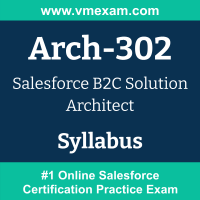 The Salesforce Arch-302 exam preparation guide is designed to provide candidates with necessary information about the B2C Solution Architect exam. It includes exam summary, sample questions, practice test, objectives and ways to interpret the exam objectives to enable candidates to assess the types of questions-answers that may be asked during the Salesforce Certified B2C Solution Architect exam.
The Salesforce Arch-302 exam preparation guide is designed to provide candidates with necessary information about the B2C Solution Architect exam. It includes exam summary, sample questions, practice test, objectives and ways to interpret the exam objectives to enable candidates to assess the types of questions-answers that may be asked during the Salesforce Certified B2C Solution Architect exam.
It is recommended for all the candidates to refer the Arch-302 objectives and sample questions provided in this preparation guide. The Salesforce B2C Solution Architect certification is mainly targeted to the candidates who want to build their career in Salesforce Architect domain and demonstrate their expertise. We suggest you to use practice exam listed in this cert guide to get used to with exam environment and identify the knowledge areas where you need more work prior to taking the actual Salesforce B2C Solution Architect exam.
Salesforce Arch-302 Exam Summary:
|
Exam Name
|
Salesforce B2C Solution Architect |
| Exam Code | Arch-302 |
| Exam Price |
Registration fee: USD 400 Retake fee: USD 200 |
| Duration | 120 minutes |
| Number of Questions | 65 |
| Passing Score | 63% |
| Recommended Training / Books |
Prepare for the Salesforce B2C Solution Architect Credential Study for the B2C Solution Architect Certification |
| Schedule Exam |
Kryterion Webassessor PEARSON VUE |
| Sample Questions | Salesforce Arch-302 Sample Questions |
| Recommended Practice | Salesforce Certified B2C Solution Architect Practice Test |
Salesforce B2C Solution Architect Syllabus:
| Section | Objectives | Weight |
|---|---|---|
| Discovery and Customer Success |
- Given a scenario, determine how to facilitate a successful customer engagement (agenda, plan, gather requirements, document, and design). - Given a set of business requirements and the understanding of standard Salesforce product capabilities, explain the reasoning and considerations to use a certain product. - Given a scenario with a B2C architecture, validate that the associated systems of record, key objects, and risks have been captured and explained. - Given a set of requirements, recommend the implementation approach and associated relative effort. - Given a scenario, articulate dev-ops lifecycle and governance required in a multi-cloud environment to achieve change management goals. |
27% |
| Functional Capabilities and Business Value |
- Given a set of customer requirements, recommend suitable B2C products and solution approach to demonstrate a customer process which includes marketing, purchase, service and loyalty. - Given a set of customer requirements for post-purchase activities in a multi-cloud solution, demonstrate how the customer experience can be achieved by leveraging Salesforce B2C products. |
7% |
| Architecture Design |
- Given the understanding of retail solution architecture and integrations, illustrate how Salesforce products interact with each other and third-party systems to support consumer commerce journeys. - Given a use case, analyze business processes and propose a customer experience solution that generates business value that meets expectations. - Given a use case, recommend a multi-cloud strategy and implementation approach to create custom personalized experiences that utilize the power of the Customer Data Platform. - Given data security and residency requirements, recommend an appropriate solution and describe how the solution's considerations can impact implementation. |
18% |
| Data Models and Management |
- Given the Salesforce supported standard object definitions for Commerce objects (profile, orders, products), articulate how key business entities relate between systems of record and systems of engagement. - Given a set of business objectives and priorities, recommend an appropriate sequence for system integration, data exchanges, and process updates to satisfy known requirements, with recommendations and potential impact to overall program delivery. - Given a set of customer requirements, articulate the privacy management features across multiple clouds, when to consider a custom solution vs. using out-of-the-box (OOTB) features. - Given a scenario, identify appropriate systems of record and describe how you would extend the standard data model for high volume processing, articulate system limitations, and recommend preferred methods for integration between various data formats. - Given a scenario that requires knowledge of common data migration strategies and standard Salesforce data migration tools, demonstrate best practices on how to transfer data between products and development environments. |
25% |
| Integration |
- Given a set of customer requirements, recommend an appropriate design and approach for a multi-cloud integration, understanding the OOTB features, system limitations, and when custom integration is required. - Given business requirements and use cases, recommend appropriate integration patterns based on data volume, latency, and system limitations. - Given a B2C use case, recommend features and approaches that ensure security for both customers and internal business users while complying with regional and local legal requirements. - Understand the recommended methods on how to integrate systems to Service Cloud, B2C Commerce, and Marketing Cloud environments using APIs and protocols that support various integration design patterns. |
23% |
